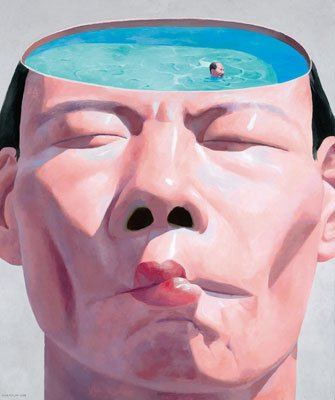Chinese Artist Can’t Stop
Laughing – on the Outside

”Sky” (1997). © Yue Minjun
Yue Minjun’s name may be virtually unknown in France, but his artwork, and above all his laugh, are instantly recognizable. His are the iconic paintings of vacant smiles on pearlescent faces, faces that have fascinated and alarmed viewers around the world almost since the moment of the artist’s debut. The Fondation Cartier in Paris has chosen to pay tribute to the Chinese painter in its latest exhibition, “Yue Minjun: L’Ombre du Fou Rire.”
The show marks an important precedent, both in Yue’s career and in the receptivity of Western audiences to Chinese art, for it is the first time that such a high-profile exhibition has been dedicated to Yue alone in Europe.
A few of the some 40 works on display have never been seen by the general public before, including pencil sketches that present some of Yue’s most celebrated paintings in embryonic form, and a number of early canvases that were completed before the artist achieved international renown. These early works speak eloquently of Yue’s growth since the beginning of his career in the 1990s and reveal a young painter brimming with verve and skill, but who had not yet found the theme that would allow him to express himself fully: the fou rire.
Unlike Yue’s later works, many of which feature the artist’s laughing face repeated on the same stretch of canvas, these early paintings depict a variety of characters, friends that Yue had persuaded to sit for him. The smiles are there, but they are not quite as grimace-like or as ambiguous as those that were to come, nor are the faces as mask-like. While this series of paintings is undoubtedly less coherent and somewhat muddier than Yue’s later canvases, it offers invaluable insight

“Water” (1998). © Yue Minjun
into the painter’s genesis, and shows the famous laughing face to be the culmination of a long period of artistic and intellectual development.
Much of the rest of the exhibition, meanwhile, is dedicated to the better-known canvases, which locate the grinning artist in absurd or surreal contexts. These include “Execution” (1995), which gained worldwide fame when it fetched nearly £3 million at a Sotheby’s sale in 2007, setting a record for a work of contemporary Chinese art. The painting shows four guffawing Yue dopplegängers lined up in front of two more doubles of the artist, one of whom points an invisible rifle at the men opposite. The contortion of the faces and bodies of these victims and the greenish tint of their bare chests take on disquieting overtones as Yue turns death into absurdity and murder into farce, and seems to be saying that individuality is more laughable than believable.
Perhaps as arresting as “Execution” is “Gweong-gweong” (1993), in which camouflaged fighter jets become virtually indistinguishable from depictions of the artist, suspended in mid-air before a clouded sky. Viewers are invited to draw their own conclusions, but as with much of Yue’s work, it is tempting to map the scene onto the broader Chinese context of increasing militarization and decreasing individuation. So, too, in a series of canvases in which Yue replicates the backgrounds of well-known paintings but strips them of all human presence, as in “Founding Ceremony” (1997), which shows an empty balcony looking out over Tiananmen Square. Dong Xiwen’s 1953 work “Proclamation of the New Nation” had filled this balcony with Mao and other political leaders, many of whom were later airbrushed out. By depopulating the balcony completely, Yue casts an ironic or despairing eye over the ease with which history destroys the individuals that shape it, while also quietly reminding viewers of the ease with which they themselves will one day be erased from the broader canvas of human history.
“Yue Minjun: L’Ombre du Fou Rire” is a triumph. For all the unreadability of Yue’s grin, his canvases provoke reflection on a number of levels: psychological, political, philosophical and aesthetic. Visitors to the exhibition may find that they emerge from the Fondation Cartier with more questions than when they entered – for Yue’s is a smile that remains truly enigmatic – but they are also sure to leave convinced of the artist’s right to international recognition as one of the most startling talents to have stepped onto the global cultural stage in the past 20 years.
Fondation Cartier pour l’Art Contemporain: 261, boulevard Raspail, 75014 Paris. Métro: Raspail. Tel.: 01 42 18 56 50. Open Tuesday, 11 a.m.-10 p.m.; Wednesday-Sunday, 11 a.m.-8 p.m. Admission: €9.50. Through March 17, 2013. fondation.cartier.com
Reader reaction: Click here to respond to this article (your response may be published on this page and is subject to editing).
Please support Paris Update by ordering books from Paris Update’s Amazon store at no extra cost. Click on your preferred Amazon location: U.K., France, U.S.
More reviews of Paris art shows.
© 2012 Paris Update
